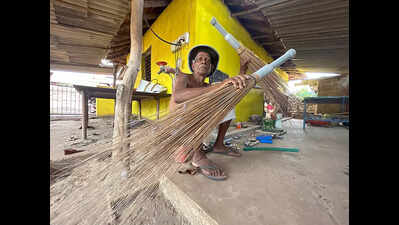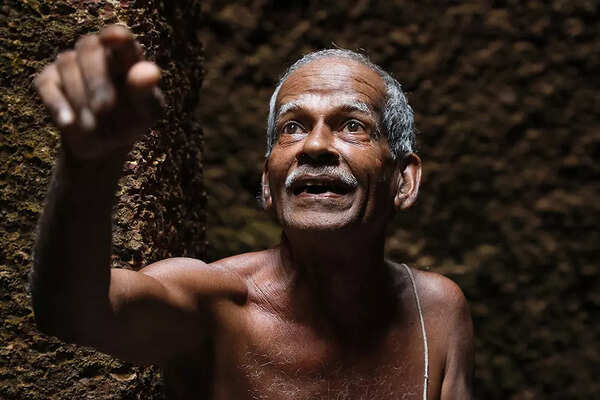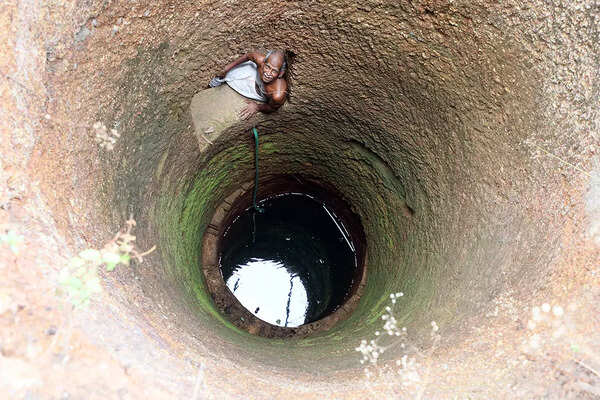ARTICLE AD BOX

The secret of Aiya’s broom lies in a special binding technique and custom grip perfected after years of experimentation
Maddi-Tolop means ‘rocky area’ in Konkani. Balakrishna Aiya, now 76, did not resign himself to water scarcity just because hope seemed to have dried up at Maddi-Tolop. His flash of human insight bypassed stony engineering dilemmas and the well he envisioned serves 25 Loliem families today

A well in the modest home of Balakrishna Aiya at Maddi-Tolop ripples like a life spring amid unyielding rocks, epitomising one man’s determination to drill through stony impossibilities to quench a community’s thirst. Visitors to Aiya’s home at Loliem, Canacona, are forgiven for missing the significance of the well outside. Then they learn the extraordinary story behind it. This nondescript water source represents far more than a simple utility; it stands as the testament to one man’s refusal to accept that fate gives no chance to ingenuity.
Idyllic but arid site
“As the name suggests, Maddi-Tolop means ‘rocky area’ in Konkani,” explains Aiya, 76, his weathered hands gesturing toward the well that has become the stuff of local legends.
“Everyone said digging a well here was impossible,” he says.The geological challenges were indeed formidable. Engineers and water experts had long written off the area due to its treacherous layers: a rocky upper crust, followed by clay, and then solid black stone beneath.F
or years, residents of this idyllic hamlet had resigned themselves to water scarcity. But Aiya saw possibility where others saw only stone.
Elegant idea breaks hard ground
“I studied the land carefully,” he recalls, eyes narrowing with the memory of those tough old times. “Then I had an idea nobody had tried before.”His innovation was practical yet revolutionary in its functionality. Once workers reached the hostile clay layer, Aiya designed an unprecedented safety feature.It was a stairway from the ground level down to that depth, creating an escape route for workers who could then dig deeper, secure in the knowledge that they had a way out if the earth became unstable.“Everybody thought I was wasting money,” Aiya reminisces, with that twinkle in his eyes that’s impossible to miss. “But when water emerged from that rocky ground, it was like watching a miracle,” he says.The well was built, but it was just the beginning of Aiya’s mission. Not content with solving his own water problems, he laid pipelines connecting his water source to neighbouring households.

For years, residents of this idyllic hamlet had resigned themselves to water scarcity. But Balakrishna Aiya saw possibility where others saw only stone
Wellspring of social service
Today, over 25 families at Maddi-Tolop have access to clean water because of one man’s engineering intuitions and community spirit.This achievement encapsulates the essence of Aiya — artist, innovator, and unlikely hero whose journey through life has been defined by transforming necessity into innovation at every turn.His life’s trajectory began in the paddy fields. As a young man, he would strategically select the fields to till based on potential earnings. Later, when he discovered schools were hiring art teachers, he completed the elementary drawing teachers’ course at Sadashivgad, Karwar — passing with distinction.
Artist, inventor, conservator
For 17 years, he taught at Shraddhanand Vidyalaya at Poinguinim before taking voluntary retirement in 2002. To supplement his earnings, he began crafting Ganapati idols — about 30 every Ganesh Chaturthi. “Crafting the idols connected me to our cultural roots,” says Aiya, who also serves as a pandit, performing pujas and guiding families through important rituals.He is often at the local temple early every morning.
His deep knowledge of the scriptures is sought after by families for life’s most important ceremonies.“Making Ganapatis alone wouldn’t have sufficed,” he says. “The demand lasts only for Ganesh Chaturthi.”While performing pujas, drawing portraits, making clay idols, and teaching, Aiya continued seeking additional ways to support his family. That search led him to an unexpected passion, broom-making.
Broom-making turns arty
Today, the rhythmic swish-swish of dried coconut ribs being boundtogether breaks the morning quiet atLoliem.His fingers move with rhythmic precision, twisting and securing each strand with practised ease. His hands move with dexterity that belies his age of 76.“Watch,” he says, brandishing a peculiarly shaped knife that resembles no standard cutting tool. “This is my own design. It trims the ribs at exactly the right angle,” he says.Within minutes, he transforms what looks like an ordinary bundle of dried palm fronds into what locals insist is the finest broom in Canacona.
The secret lies in a special binding technique and custom grip that Aiya perfected after years of experimentation.“Feel the balance, the beauty and the strength,” he says, extending his creation. The broom indeed sits differently in hand — lighter at the sweeping end, with a perfectly contoured grip that feels custom-made for the palm.“Pull as you might, the grip won’t separate from the broom,” he says. “This broom will last several times longer than the ordinary ones.”

The ground comprises a rocky upper crust, clay, and solid stone. Balakrishna Aiya built a stairway to the clay layer
Creating culture custodians
His handcrafted brooms have become coveted household items, selling for Rs 250-300 each. Producing between two and six brooms daily, Aiya has transformed a common cleaning tool into an art form that generates meaningful income.But like his approach to the impossible well, Aiya’s vision extends beyond personal success. He is keen to pass on his sustainable craftsmanship to the younger generation.His vision is ambitious: introduce broom-making in schools as a skill-based course, creating what he calls “an army of 400-500 experts” who can preserve and evolve this practical art form.“Besides learning sustainable craftsmanship, things provided abundantly by nature are put to judicious use,” he says.When not crafting brooms, painting, or conducting rituals, Aiya has experimented with grafting hundreds of mango varieties across Canacona and continues exploring new innovations in traditional crafts.
Knowledge is for giving
His contributions have not gone unnoticed. In 2010, he received the Kala Gaurav Puraskar for his artistry, and in 2023, the Goa State Biodiversity Board recognised his work in preserving traditional knowledge and sustainable practices.Yet sitting among his tools and innovations, awards seem far from Aiya’s mind. His worn hands never stop moving — whether binding brooms, sketching portraits, or blessing families through sacred rituals.“What good is knowledge if it dies with you?” he says to articulate his philosophy. “What good is innovation if it doesn’t help your neighbour?”



.png)
.png)
.png)
















 1 day ago
5
1 day ago
5









 English (US) ·
English (US) ·